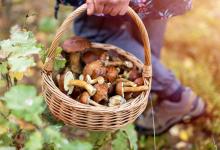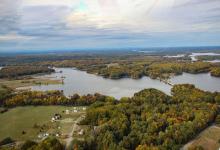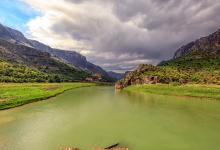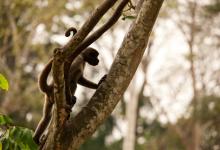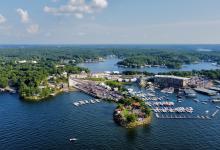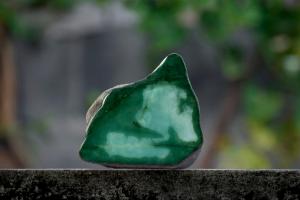Termites in Hawaii: Types, Risks, and How to Prevent Them
Hawaii is a wonderland of lush, tropical greenery, sands of all colors, and volcanic activity. As the spirit of ‘Aloha’ resonates throughout the island, a hidden threat lies just beneath the surface. And this time we aren’t talking about magma. Termites quietly infiltrate homes and surrounding landscapes, posing significant risks. Discover the types of termites in Hawaii, the risks they pose to paradise, and prevention methods.
Hawaii’s Termite Problem
wreak havoc on mainland landscapes as well as island getaways. They are a worldwide concern that has found a hospitable environment on Hawaii’s many islands. Several factors contribute to the termite problem in the Aloha State, including:
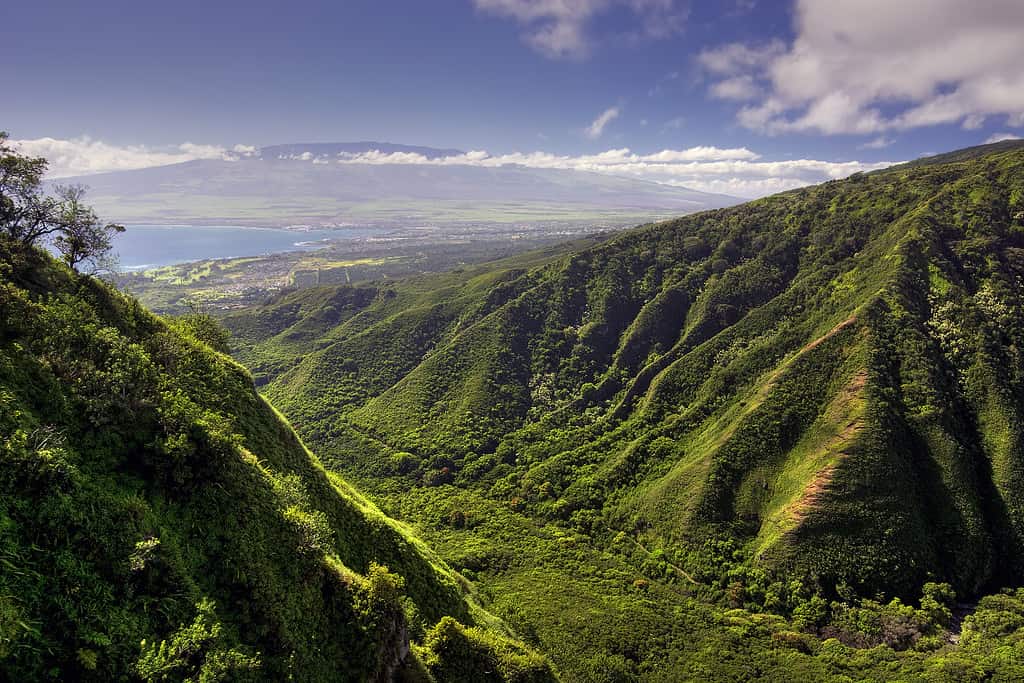
Hawaii’s warm and humid climate fosters year-round termite activity, driving local termite species to adapt to their environment in unique ways.
©7Michael/iStock via Getty Images
Ideal Climate
Hawaii’s warm and humid climate creates an ideal breeding ground for termites. Its year-round conditions support termite colonies, allowing them to thrive and expand rapidly. Additionally, Hawaii’s temperatures rarely drop below termites’ comfort zone.
Wood Resources
Termites feed on cellulose, which is abundant in wood and plant materials. Hawaii’s diverse vegetation and substantial use of wood in construction provide termites with an ample food source. From historic wooden buildings to lush forests, termites have plenty of options to sustain their colonies.
Location
Hawaii’s Department of Agriculture, along with Fish and Wildlife, work hard to keep out unwanted pests and plant diseases that could decimate the isolated islands. lies thousands of miles from the mainland United States. Its isolation creates a unique and natural environment. However, this environment has also not evolved with defenses against invasive species, including termites. The islands also lack natural predators and competition that allow termites to thrive.
Types of Termites in Hawaii
Several species of termites call the Hawaiian Islands their homes. Understanding these termites is essential to combatting their presence. Hawaii is home to seven major termite species:
- Drywood termites: Kalotermes approximatus and Incisitermes minor
- Subterranean termites: Coptotermes formosanus and Reticulitermes flavipes
- Dampwood termites: Neotermes castaneus and Zootermopsis angusticollis
- Conehead termites: Nasutitermes corniger
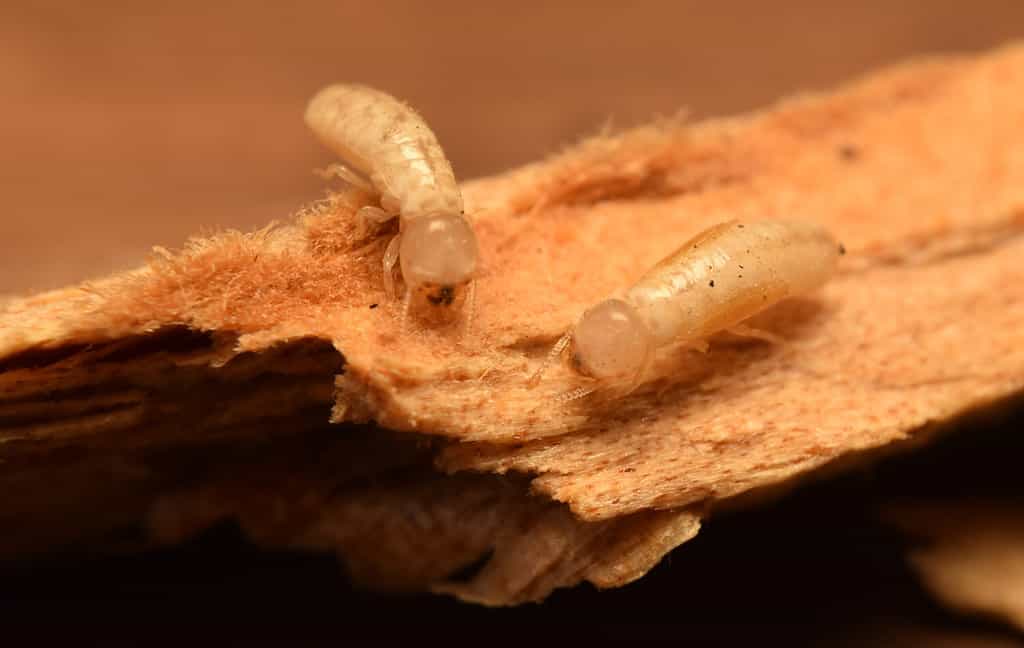
Kalotermes approximatus and Incisitermes minor live entirely within the wood they consume, bypassing the need for soil contact, setting them apart from other termite species.
©gunawand3570/Shutterstock.com
Drywood Termites
Drywood termites infest dry, untreated wood, including timbers, furniture, and decorative items. They do not rely on contact with soil or underground colonies. Instead, establish independent colonies within the items they infest. Furthermore, these termites engage in swarming events to reproduce and establish new colonies. These swarming events produce winged reproductive termites known as alates. Drywood termites are small, measuring 3⁄8 inch. They are also pale or ivory, appearing almost translucent.
Subterranean Termites
Unlike drywood termites, subterranean termites rely on soil contact, making them a prolific problem in the Aloha State’s naturalized areas. They rely on soil for moisture and foraging. Subterranean termites also construct underground colonies with as many as thousands of individuals.
Additionally, they construct mud tubes to access above-ground food sources. Subterranean colonies comprise workers, soldiers, and alates. Workers provide foraging and nest maintenance while soldiers defend the colony. Similar to drywood species, subterranean alates are also winged reproductive termites. Both workers and soldiers are ivory to pale yellow while the alates have dark bodies with transparent wings.
Dampwood Termites
Dampwood termites thrive in the humid tropical environment of Hawaii. They prefer damp and decaying wood, high humidity, and waterlogged areas. They are also less reliant on soil contact than subterranean species, and instead, rely on the damp wood they infest.
The workers and soldiers of drywood colonies are larger than other species. They measure around 1 ⁄ 2 to 3 ⁄ 4 inches and are reddish-brown to dark brown. The moist wood they infest also decays as tunnels and galleries appear.
Conehead Termites
Conehead termites are a new and invasive addition to Hawaiian landscapes. They are aggressive and arrive on the islands through human activity and cargo transportation. They do not rely on underground colonies. Instead, they construct surface nests on trees or in structures, making them the most visible termite species.
Conehead termites are aggressive foragers. They also create intricate patterns on wood surfaces while feeding. The destructive pests have elongated, oblong bodies with large jaws. They are also orange-brown with darker heads.
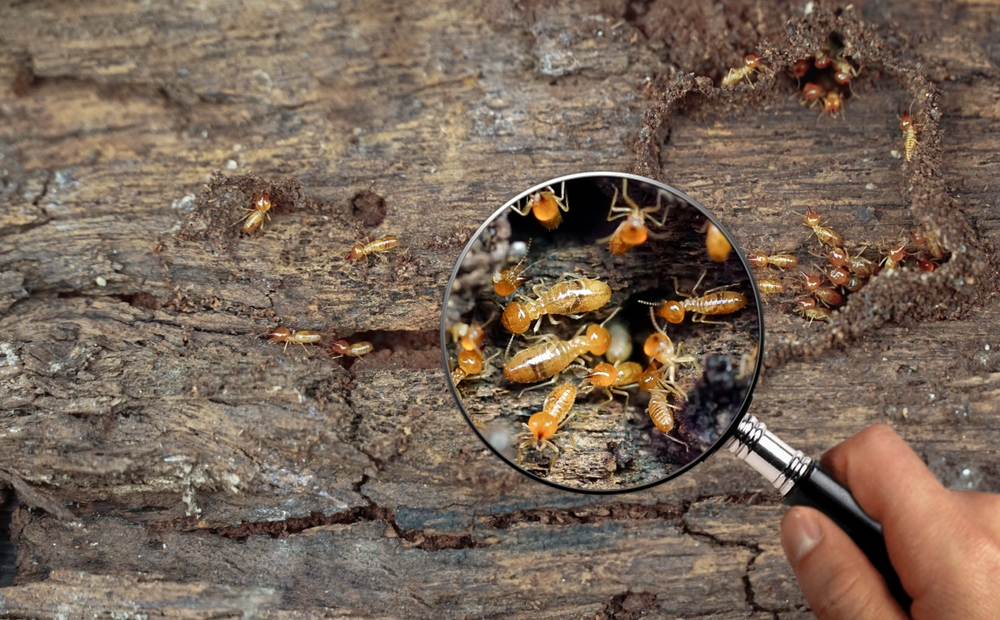
©Oasishifi/Shutterstock.com
The Geographic Distribution of Hawaii’s Termites
Hawaii offers a diverse geography from lush tropical rainforests to sandy beach retreats and secluded volcanic hideaways. The various microclimates of the islands also create a unique distribution of termite species.
Drywood Termites
Find drywood termites throughout Hawaii. In fact, homeowners and businesses have reported infestations on all major islands. However, they are most prevalent in coastal and urban areas like Honolulu.
Subterranean Termites
Like drywood species, you can also find subterranean termites on all of the major islands. They are most prevalent in the moist soils found on the windward sides of the islands.
Dampwood Termites
Found in moist and forested regions, dampwood termites are common in various parts of Hawaii. However, they are less common on the arid, leeward sides of the islands and in urban areas.
Conehead Termites
Experts have identified the newest member of the Hawaiian termites on two islands: the Big Island of Hawaii and Maui. Conehead termites are not widespread, but they have the potential to spread further.
The Risks Associated With Termites
Termites are silent destroyers that pose significant risks to property and homeowners as well as Hawaii’s ecosystems. Here are some of the key risks associated with termites:
Structural Damage
Termites feed on cellulose found in wood. They tunnel through wooden components of homes, buildings, and infrastructures, significantly compromising their structural integrity over time. Furthermore, repairing termite damage is costly and often involves replacing damaged wood, reinforcing structures, and pest control treatment applications.
Economic Impact
Termite infestations lower resale values and damage the real estate market. Homeowners and property owners must also pay for continuous control and prevention.
Ecological Consequences
Invasive termites disrupt the natural processes of the Hawaiian islands. They feed on delicate native plants and trees causing harm to the Aloha State’s unique biodiversity while damaging native vegetation.
Health Concerns
Termite infestations cause moisture buildup that creates an environment that causes mold growth. Mold poses many health risks to occupants. Furthermore, termite droppings and body parts trigger allergies and exacerbate respiratory conditions.
Signs of a Termite Infestation
Most homeowners don’t realize they have a termite infestation until significant damage has occurred. Recognizing the early signs of a termite infestation is essential. Here are key indicators to watch for:
- Hollow wood: Knock on wooden surfaces, such as walls, beams, and furniture. If the wood sounds hollow, it could indicate termite presence.
- Mud tubes: Mud tubes appear as narrow, brown, muddy lines along walls, foundations, and wooden structures.
- Wings: The reproductive termites, or alates, shed their wings after landing. Watch for wings near windows, doors, or light sources.
- Wood damage: Look for small, intricate tunnels within wood. Additionally, small holes in the surface of infested wood can also signal activity. Furthermore, infested wood will crumble or crack easily when touched.
- Seasonal swarms: Winged reproductive termites swarm in the spring.
- Droppings: Termite droppings, known as frass, resemble tiny wood-colored pellets or sawdust. It accumulates near termite entry points and infested areas.
- Bubbling paint: Termites that feed beneath painted surfaces causing bubbling paint.
- Mud: Termites seal cracks and crevices near their infestation sites with mud.
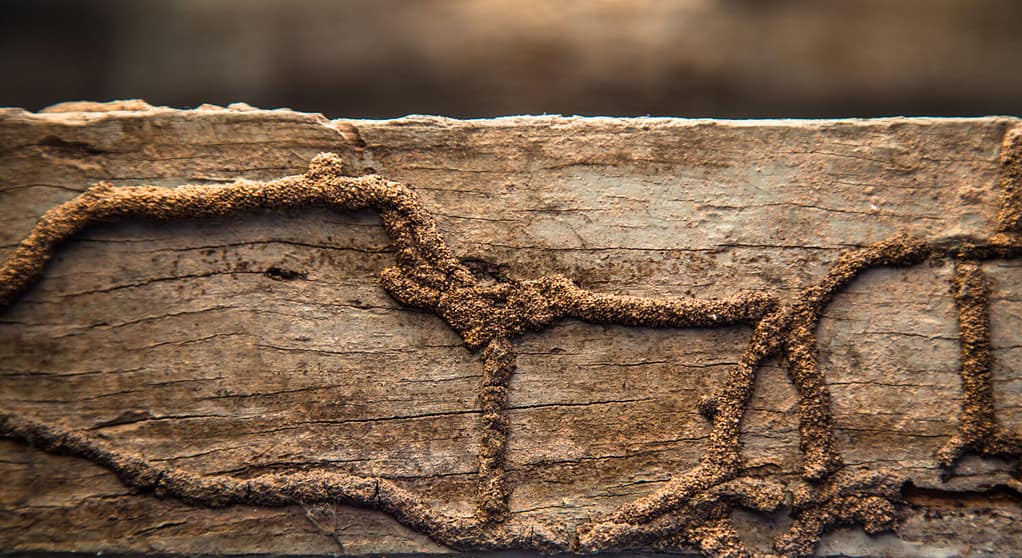
©Chaikom/Shutterstock.com
Preventing Termite Infestations in Hawaii
, including its lush landscape and tropical climate, creates ideal conditions for thriving termite populations. Preventing infestations in the Aloha State is essential. Follow some effective strategies to protect your home and property:
Landscape Maintenance
Termite prevention starts inside and outside of your home. Start by ensuring that your property has adequate drainage systems to prevent water from accumulating near your home’s foundation. Additionally, be sure to repair leaks promptly.
Elevate wooden structures like decks and landscaping features to minimize wood-to-soil contact and prevent subterranean termites. Furthermore, regularly trim and maintain the vegetation around your home to reduce nesting sites. You can also choose termite-resistant plants that are less likely to invite termites into your landscape.
Termite-resistant plant varieties for Hawaii yards include:
- (Bambusa spp.)
- (Strelitzia reginae)
- Bougainvillea (Bougainvillea spp.)
- Croton (Codiaeum variegatum)
- Hibiscus (Hibiscus spp.)
- Kupukupu Fern (Nephrolepis spp.)
- Naupaka (Scaevola spp.)
- Ohia Lehua (Metrosideros polymorpha)
- Plumeria (Plumeria spp.)
- Ti Plant (Cordyline fruticosa)
Termite Inspections
Conduct regular inspections of your property to check for termites. Be sure to check all wooden structures, including outbuildings. Watch for signs of activity such as mud tubes, droppings, and damaged wood. Furthermore, consider scheduling annual termite inspections by a qualified pest control professional. Most of Hawaii is a high-risk termite area, and professional inspections give you peace of mind.
Professional Termite Prevention
Pest control experts offer preventative treatments, inspections, and eradication techniques. Soil treatments and bait systems create barriers around your property.
Termite-Resistant Building Materials
Use termite-resistant building materials for new construction and home renovations. Pressure-treated wood and concrete block foundations resist infiltration.
Home Maintenance
Aside from taking care of your landscape, keep your home well-maintained. This includes sealing cracks and crevices around foundations, walls, and roofs. Additionally, pre-treat wood, paying special attention to eaves and attic areas with termite-resistant products.
Eco-Friendly Termite Control Options
Many locals value sustainability and preserving the precious Hawaiian ecosystem under the spirit of ‘Aloha.’ Consider adding some eco-friendly termite control options to your overall prevention plan.
- Boric acid: This natural compound derived from boron, has minimal impact on non-target species and the environment. Termites ingest the boric acid and it disrupts their digestive systems.
- Orange oil: Apply orange oil to termite-infested wood to disrupt the termites’ exoskeletons and respiratory systems.
- Non-toxic bait systems: Place bait stations strategically around your property to eliminate colonies.
Always consult a pest control expert at the first sign of termites. They can assess your situation and recommend a suitable and environmentally friendly approach to protect your home and Hawaii.
The Role of Homeowners in Protecting Hawaii’s Ecosystem
Hawaii’s ecosystem is a treasure, and the state plays home to over 9 million visiting tourists annually. Its residents play an important role in preserving the delicate balance of Hawaii’s ecosystems. Here are some ways you can contribute to its preservation:
- Choose native plants: Opt for native Hawaiian plants. They require less water and provide habitats for native wildlife.
- Manage invasive species: Monitor and remove invasive species that disrupt the ecosystem.
- Conserve water: Plant drought-tolerant species and implement rain barrels alongside efficient irrigation systems.
- Reduce chemicals: Limit chemical use including fertilizers and pesticides.
- Compost: Compost your kitchen scraps and yard waste to reduce landfill waste and create nutrient-rich soil for your garden.
- Provide habitat: Leave areas of your property that are away from structures undisturbed to create habitat-friendly spaces for native birds, insects, and mammals.
Silent Destroyers: Termites in Hawaii
Prevention is the key to controlling termites in a climate where they thrive like Hawaii. Regular inspections, termite-resistant building materials, and eco-friendly control methods work together to eradicate the pests. Preserve paradise and Hawaii’s ʻāina, keeping its natural and untouched mystery alive and well.



